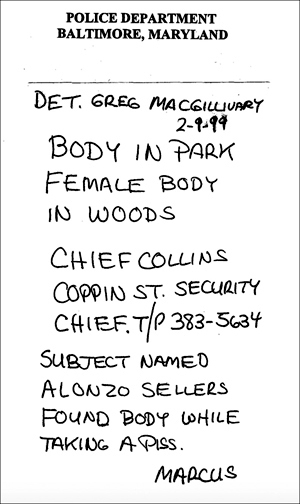
Verily we belong to God and to Him we shall return.
Holy Quran 2:156
Alonzo Sellers is no stranger to the law. His list of charges is robust, including an occasional assault here and there, but mostly they reveal that he suffers from a rather colorful compulsion. Between 1994 and 2015, Sellers had been charged with indecent exposure eight times, once jangling his junk whilst completely in the buff right in front of a female police officer. Sellers is a habitual streaker.
In 1999, Sellers was forty years old and worked as a groundskeeper at Coppin State University in Baltimore, less than five miles from his home in Gwynn Oak, Maryland. The total travel time, during non-rush hours, was approximately fifteen minutes.
On February 9, 1999, Sellers was at work when he found himself in need of a plane to shave down a doorframe. He decided to go home and fetch one that afternoon.
According to Sellers, he arrived home, grabbed a twenty-two-ounce beer and the plane he needed, and headed back. He was in his truck, traveling west on Franklintown Road. A few miles from the college he felt the call of nature—the beer having run its course—so he pulled over.
Police reports don’t indicate where he pulled over. There was no space on his side of the road. There was a small place to pull over on the opposite side, where he ended up making his discovery.
But he didn’t stay by the side of the road. Ostensibly searching for a place to urinate, he wandered more than a hundred feet into the woods north of the road, the ground covered in places by spots of snow and ice, and he came to a stop at a large fallen tree close to the water. A video taken by Adnan’s attorney Cristina Gutierrez months later in September 1999, found easily on YouTube, shows the trek Sellers would have taken on this particularly cold day—the temperature hovered between 30 and 40°F—an unlikely slog for a simple leak.
Then, according to Sellers, he stepped over the tree, unzipped his pants, and froze. He had nearly stepped on something.
Peeking through the dirt, a few yards from the stream and close to the log, was a patch of black hair. A bit of white fabric poked up through the dark earth next to the hair. A few feet farther, a small mound rose up slightly, the outline of a hip, dipping back into the dirt.

Sellers zipped his pants up, forgetting to urinate, and made his panicked way back to the road and his truck.
On that bitingly cold February day, far from the road, between a stream and a dead tree in Leakin Park, Sellers had found a body.
* * *
Chief of Security Ronald Collins from Coppin State College called Baltimore City’s Police Homicide Unit at approximately 1:20 p.m. on February 9, 1999, to report Sellers’ discovery. According to Sellers, he had raced back to work, upset and unnerved. Shortly afterward Detectives Greg MacGillivary and William Ritz arrived at Coppin to meet Sellers, and he directed them to the 4400 block of Franklintown Road. The detectives, accompanied by Sellers, made their way to Leakin Park, where he led them to his horrid find.
The city surveyor, Phillip Buddemeyer, would later testify that he nearly stepped on the body, it was so difficult to see. The sun had begun to set, which may have added to his trouble in seeing what pictures of the burial site, taken with floodlights set around the perimeter, clearly show—a partially buried female body. In the light of day, when Sellers had been there hours earlier, it may have been much more apparent.
The body lay nearly parallel to the far side of a forty-foot tree, also referred to as a log in the records, hidden from the road. The head pointed southeast, feet pointed northwest, and both log and body were at a roughly 45-degree angle from the road, the farthest end reaching toward Dead Run Creek.
The victim was announced DOA at 1400 hours.
As dusk fell, the crime scene unit began excavating the body, brushing away the few inches of gathered earth to uncover, bit by bit, the slender frame of a young Asian woman.
She lay on her right side, her left leg on top of her right leg, her torso slightly twisted so that her head was turned facing downward at a 45-degree angle from the ground. Her head almost rested on her outstretched right arm, as if asleep. Her right arm didn’t lie flat, instead it angled upward, bent at the elbow, and her right hand poked through the dirt, slender, small fingers frozen in the air. A single large rock had been placed on that arm, maybe to force it down, an indication that perhaps the body (or at least that arm and hand) were in rigor when she was left there.
Her left arm was twisted behind her, bent at 90 degrees, her left hand resting against her back.
She was clothed, but her clothing was disheveled. She wore a white jacket over a gray-blue blouse and, from photographs though not mentioned in reports, a white knit shirt inside of that, both of which were bunched up in the front. Under the blouse her bra was pulled above her breasts, exposing them. Her long black skirt was gathered above her waist, she wore underwear, and her pantyhose were mostly intact, with a few small but distinct tears. She had no shoes on, but wore a white metal school ring, a second white metal interlocking ring, and two necklaces—a gold one with a charm and a silver one with a heart pendant.
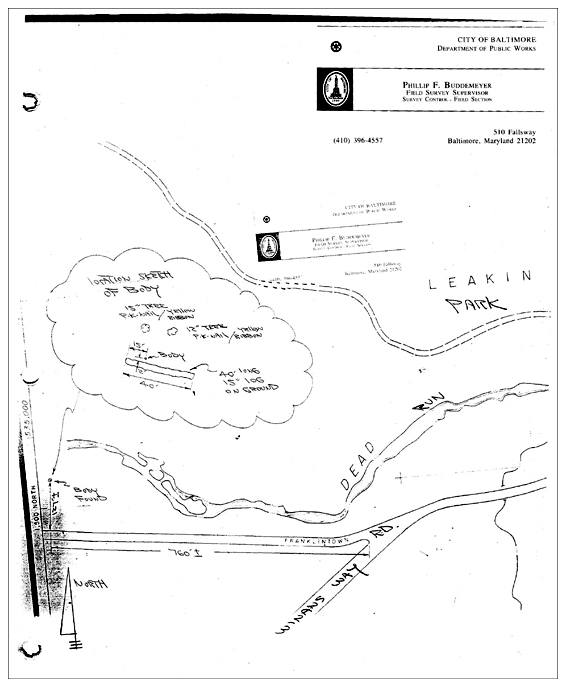
Crime scene sketch
If anything, it was abundantly clear that she was not carefully placed into this spot. The body was in an unnatural position. She had been dumped and hastily covered over.
The body was taken to the Chief Medical Examiner’s office where it was properly identified, though the police must have immediately suspected who it was. It took some effort for the medical examiner to get partial prints from the body, which were compared to latent prints from the Lee home. The victim had sustained blunt force trauma to two parts of her head, the rear right portion and right side, causing “focal and poorly delineated right occipital subgaleal and right temporalis muscle hemorrhage.”

The hyoid bone, which supports the tongue, was dislocated. The cause of death was strangulation.
The young victim was conclusively identified as Hae Min Lee. The missing person’s case was now a homicide.
* * *
The crime scene report, dated June 10, 1999 (reports in this case often being written months after an event) reads:
The crime scene is found in the 4400 blk. N. Franklintown Road within Leakin Park. A body is located partially buried approximately 127 feet from the road, next to a fallen tree, within a wooded area in a shallow grave.
A empty half pint bottle is located several feet from the remains along with a section of clothes line.
Feathers are located on a section of the fallen tree, same are photographed and recovered.
Six 9mm. cartridge casings along with thirteen .40 caliber cartridge casings are observed in the street and along the roadside. These casings are photographed and recovered.
A rolled condom and wrapper are also observed along side of the road. These items are photographed and recovered.
Several Block Buster cases are observed on the opposite side of the street, these items are photographed and recovered.
Several tire tracks are discovered in the soil just off the roadside which is described as a parking area. These tracks are photographed and casts are made to preserve the indentations.
After the body is disinterred, a fiber is observed under U.V. light, on the victim’s outer garments [sic]. A second fiber is found after the remains are removed. This fiber is observed on top of the soil, and is illuminated under U.V. light. These fibers are recovered and are submitted into evidence at the Evidence Control Section with the proper Laboratory requests.
On 10 February 1999 at approximately 0900 hours, an [sic] Post Mortem Examination is conducted on the victim that is disinterred from Leakin Park. The remains are that of an Asian Female approximately seventeen to twenty years of age. The examination is conducted by Doctor Aquino, Associate Medical Examiner and supervised by Doctor Marguerite Korrell Deputy Chief Medical Examiner.
At the conclusion of the examination, it was determined that the victim met her demise as a result of Manual Strangulation. Doctor Korrell ruled the manner of death a Homicide.
According to the crime scene narrative, written the same day by Detectives MacGillivary and Carew, the area was cordoned off, and photographs and video of the body were taken. As the medical examiner and crime lab technicians got to work, the detectives turned their attention to Sellers.
His story of how he discovered Hae’s body would raise eyebrows in any event, but particularly so because of his criminal record. A history of streaking certainly makes it less likely that a man would take such pains to be discreet.
Having been to the burial site numerous times, to me the story seems unlikely. There is no path back to the site. Some have suggested that Sellers may have been back there streaking, but streaking technically requires an audience.
According to Sellers, he had downed a 22-ounce beer in a matter of minutes, and taken a longer, more winding route back to work. The natural route would have been Windsor Mill Avenue, a main thoroughfare that is not only shorter, but has more lanes and would have been nearly clear around lunchtime. Equally problematic: his home in Gwynn Oak is virtually across the street from Woodlawn High.
All of these things should have bothered the police, and initially it seems they were suspicious, because they subjected Sellers to two different polygraph tests.
It’s not unheard of for the perpetrator of a murder to alert the authorities or call in a tip themselves related to the crime or the victim. But in this case it seems unlikely, given Sellers’ panicked reaction and fairly innocuous criminal record, that he had anything to do with the crime. Reporting the body was, if anything, the act of a good Samaritan.
The question was not so much whether Sellers had committed the crime, but whether he had heard something that led him to look for the body. And that’s precisely what the first polygraph test sought to determine.
On February 18, nine days after discovering the body, Sellers was first brought in to take a lie detector test. He was told his rights, which he waived entirely. The first time he was tested, he was asked only four questions specific to the murder.
The result was not good for Sellers. The examiner wrote that “Mr. Sellers seemed to be preoccupied with outside issues. He appeared to be nervous and time-conscious.” The conclusion: “Final Call: Significant responses that would normally indicate deception. (Deception Indicated).”

February 18, 1999 polygraph questions.
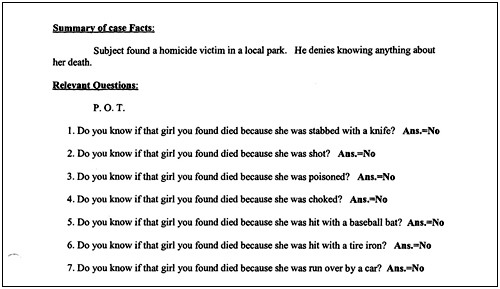
February 24, 1999, polygraph questions.
Here is where the police conduct gets weird. They brought Sellers back on February 24 to take another test, but with totally different questions.
This time Sellers passed with flying colors.
Most jurisdictions in the United States stopped allowing polygraphs as evidence of truthfulness long ago, and in this instance it also seems the police had little faith in a polygraph. If they did indeed believe that these examinations would yield reliable answers to the questions on the first polygraph, common sense would dictate they would repeat the same questions on the second.
But they didn’t. So then what was the point of this exercise?
The most reasonable explanation to me for the two distinctly different tests is this: the police wanted to eliminate Sellers as a suspect and dispense with him altogether. When he failed the first polygraph, they decided to give him a second one designed to make sure he passed, instead of further exploring why he failed on questions in the first one
After the second polygraph, Sellers was never contacted by the police again. This would be the last time he appeared in the case until he testified in the murder trial of the person the police had been eyeing even before Hae’s body was found: Adnan.
* * *
In her 1969 book On Death and Dying, Elisabeth Kübler-Ross developed a model for understanding how people commonly cope with loss, widely known as the five stages of grief. She later clarified that the stages are not necessarily linear, but instead are the most universally expressed human responses to loss.
In tragic situations the most frequent immediate reaction is denial.
According to nearly everyone who was questioned, Adnan initially refused to believe that the body found in Leakin Park could be Hae’s. He argued, between tears, that it must be another Asian girl. There was a significant Korean community in the area, after all.
On the night of February 10, 1999, news of the discovery of Hae’s body spread quietly but quickly among her friends. Aisha was the first to hear when Hae’s brother called her. Aisha then alerted Krista, who contacted Adnan. Adnan was home and didn’t have his car that night (it was shared by his family), but when he heard the news, he ran all the way to Aisha’s house.
Krista still clearly remembers the events of that night, and the following few days:
She called Adnan between 10:40 p.m. and 11:00 p.m. but at first didn’t reach him, so she left him a voicemail. She called back two minutes later and he answered the phone. He sounded happy, but she knew what she was about to tell him was completely going to change his life. She told him that they had found Hae and that she was dead. Initially he seemed to be in complete shock and unable to speak. After a few minutes of silence on his end, Krista asked if he was going to be okay, then told him to come over to her place if he needed to. Adnan finally responded, asking if Aisha was home. Krista said she was, and Adnan said he was going to go over to her house instead. Krista phoned Aisha to let her know Adnan was on his way, and she asked Krista to come over as well, since she wasn’t emotionally equipped to handle Adnan on her own. Krista arrived at Aisha’s house around 11:30 p.m., pulling up at the same time as Stephanie McPherson, to find Adnan sitting at the kitchen table crying. When he calmed down enough to speak he said that there had to be a mistake and that Hae was still alive because her name was written on Aisha’s agenda book. Krista recalls that Adnan used his cell phone to call Detective O’Shea, but the detective wasn’t in. Adnan started crying again and Krista took the phone from him and spoke with the police officer to explain that they just wanted to get some information. The officer instructed the kids that they needed to call homicide in the morning—there wasn’t anyone there they could talk to now.
The friends stayed at Aisha’s house until about 12:45 a.m., and then Krista took Adnan with her because she didn’t think it was safe for him to walk home alone that late at night. She dropped him off in the parking lot across the street from his house and he ran home from there.
By the next morning, the entire school knew that Hae was dead.
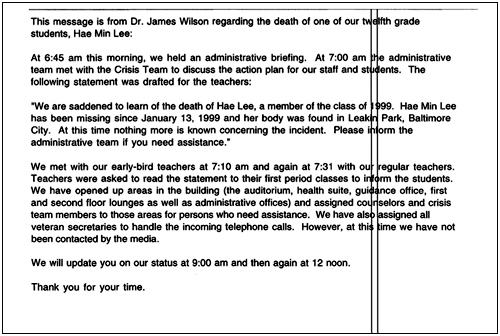
The Magnet Program circle of friends were all at school that day, seeking comfort in the familiar and bonding over an incomprehensible loss.
Students and teachers alike approached Adnan to console him; he was dazed, still in denial, unsure of how to deal with the outpouring of sympathy. Sympathy for what? For the death of his ex-girlfriend or the death of his friend? It was all too much for him.
He went to the nurse’s office, where his friend Ja’uan Gordon came to see him. Adnan was irritated with the nurse, who kept pressing him and insisting that he believe the news. Ja’uan remembers Adnan’s denial, the nurse literally shaking him, and then seeing him “break down” in tears. Quivering and upset, Adnan got a pass to leave school with Ja’uan and went to the home of another Woodlawn friend, Peter Billingsley, who was on the yearbook staff along with Adnan. Hae had also been part of their yearbook team.
A number of friends were gathered at Peter’s house, and Adnan retreated to the basement. After a while they found him downstairs alone in a corner, crying. Peter noted that he had been sobbing for over two hours. Krista remembers it like this:
Laura, Aisha, and I went to pick up lunch and took it back to Peter’s house. Adnan was very quiet, kept to himself and cried a lot. Several times he went downstairs and locked himself in the bathroom. After we left Peter’s house Aisha and I went to her house for the afternoon. Adnan called and stopped by to hang out for a little while. As we were watching TV the previews of the five o’clock news came on and the discovery of Hae’s body was the top headline. As we watched the story you could tell by his reaction that Adnan realized that Hae really wasn’t coming back. All he could do at that very moment was lay in my arms and cry.
Adnan remembers feeling sheer disbelief. He had never seriously considered that Hae might not ever return, that she might be dead, that she might have been hurt or killed. Neither had any of their friends.
The discovery of Hae’s body shocked them to the core. Krista says “February 10, 1999, was the day we were forced to become adults. We were struck with real life tragedy and lost someone we cared very deeply for. We lived more aware of the world around us and that bad people existed. As a group of friends we vowed to watch out for each other and stay in constant communication, so that none of us would just disappear again.”
But there would be no waking from what Adnan wished was a bad dream; his nightmare was just beginning.
Adnan:
It was toward the end of that fourth week that Krista called me one night. She was crying as she told me she had just heard that a body had been found, and that the police believed it was Hae’s. She told me she would meet me at Aisha’s house, so I left home and went there. The three of us sat at the table in her parents’ kitchen, and I had this strong feeling of disbelief. I even recall arguing with them about whether or not the police could’ve been mistaken. Afterward, I just remember us crying together, and having this overwhelming feeling of sadness, in a way that I had never felt before.
That night was almost 17 years ago; literally, half a lifetime away. And of all the horrible things I’ve experienced, from that day till this—nothing has ever compared to that sorrow. Beginning to realize that I would never see Hae’s smile, or hear her laughter, or enjoy the warmth that she brought into our lives, ever again? I don’t think I’ll ever have the words to describe the grief of that moment.
Going back to that night, after leaving Aisha and Krista and going to school the next day; well, everything was pretty much a blur. I just recall going through the motions of life, school, work, etc. I remember feeling a mixture of shock and disbelief, coupled with an immeasurable amount of sadness over her loss. We began planning Hae’s memorial service, and I think that is when it really hit home. That I would never again see a person that I loved so much.
It was the saddest time in my life. Each of those days kind of faded into the next. And it would only be 19 of them, until I was arrested.
* * *
The next day, Friday, February 12th, Saad took Adnan on a long drive to help clear his head. Adnan was coping, but not well. An observant Muslim home offers no outlet to express anything about a forbidden relationship, and while things have improved slightly now, in 1999 no counseling was available in Muslim communities. Approaching a religious leader about the loss of someone he wasn’t even supposed to be friends with, much less date, was a no-go. And many Muslims, like those in other conservative faith communities, have lived their lives swallowing grief and processing pain on their own. In religious circles those who suffer through divorce, abuse, addiction, and loss are often encouraged to pray more and have patience, without any attention to mental health or any prospect of real healing.
Of course, Adnan was also in high school, a teenager. How many teens seek the comfort of their parents or other adults in times of crisis? They rarely do; instead they turn to friends and peers. Adnan had his friends at Woodlawn, but they did not have the same relationship and friendship with Hae as he did; they also wouldn’t understand his faith perspective.
Together, Saad and Adnan headed to western Maryland, our former home and where Saad grew up. Interstate 70, whose eastern end hits Baltimore not far from Woodlawn High School, stretches in the opposite direction for nearly a hundred miles through scenic countryside, all the way to the Pennsylvania border. They drove west on I-70, crossing over the Monocacy River, before veering off onto Route 15 toward Catoctin Mountain.
The temperature was near freezing so they didn’t get out of the car. Saad drove through Cunningham Falls State Park, letting Adnan sit in silence as they listened to music—hip-hop, R&B, some occasional bhangra.
They got back on the interstate and kept heading west, to Hagerstown. Right inside the town limits was a small mosque, established in the years after we had moved to Baltimore. They stopped to pray the weekly congregational Jummah prayer after listening to a sermon, and then Saad took Adnan to Rocky’s Pizza, his favorite comfort food spot, for lunch.
Between hot, gooey slices of pizza they spoke about Hae and what could have happened to her. Adnan had no idea; there was no public information about how she died. All they knew was that she’d been found in Leakin Park. And they didn’t even know where Leakin Park was.
In fact, most of us didn’t. Many of us had never driven that way. It was an internal route to the city that we weren’t even aware of, and the only part of the city my family ever went to was the Baltimore harbor, usually with guests. To get there, we simply hopped onto the interstate because it took you almost directly there. And for those who may have actually driven past that area, they never realized that it was called Leakin Park; there was no sign on Franklintown Road identifying the woods to either side as an actual park.
As they drove back they tried to reconcile themselves with Hae’s death. In Islam, life and death are already decreed by God. We are each born with certain things preordained: the amount of our “rizq,” or sustenance, be it food or money, and the time of our death. Even before we enter this world our days and nights are written, numbered, noted by the angels in our individual decrees of life. We must live, then, like travelers in this world, treating it like a temporary abode, until we move on to our eternal homes.
Muslims are given three days to mourn unless the deceased is their spouse. Any more than three days is considered disrespectful to God because every soul came from Him, belongs to Him, and will return rightfully to Him. We don’t own each other, only God owns us.
Adnan’s discussions with Saad, and later with his mosque mentor, Bilal, helped him manage what he could barely accept as reality, but he still carried a deep sadness. Yusuf recalls Adnan taking him out for dinner one night, during the last week of that month. Even as a child Yusuf knew something was wrong. His big brother was unusually somber, even as he attempted to make small talk with Yusuf, who prattled on about Dragon Ball Z. It was a memorable dinner for Yusuf because it was the last time he spent time alone with Adnan.
* * *
On February 11, two days after Hae’s body was found, something odd happened. A “walk-in witness” showed up in the Woodlawn Stationhouse of the Baltimore City Police. The forty-one-year-old black man had seen media reports that evening that a murder victim had been found in Leakin Park, and he thought he had seen something that may have been connected to the crime. The police officer on duty called the Homicide Division and Detective Ritz arrived with a colleague to speak with him.
The man had seen a black man driving a light-colored vehicle and acting suspiciously by some concrete roadblocks on a road leading to another part of Leakin Park, about a mile from where Hae’s body was found. The officers’ report is sparse. It doesn’t note the time of the incident, why the man was suspicious, or why the witness thought it might be connected to the murder. The police quickly dispensed with the man, concluding “investigators believe that this observance is not connected to the murder of Hae Lee.” No one ever contacted him again.
That same evening the police pulled the registration records for Adnan’s car. Having checked to see if he had a criminal record on February 3rd, the police seem to have considered him their prime suspect all along.
As Hae’s family, friends, and community tried to cope with the horrific news, the police went into overdrive to close their case. This was not the average Baltimore murder, not a gang-bang killing, not a drive-by, not a drug crime. This also wasn’t the average Baltimore victim, mostly black and poor. Hae was a bright, promising honor roll student from the suburbs. She belonged to a family and a community with a strong local business presence, and a church that rallied around them. The murder of Jada Lambert, the young black girl who was found dead seven months prior, did not get the same investigatory vigor or media coverage as Hae’s case, and I don’t hesitate to say that the victim’s “profile” made all the difference.
In a city with a terrifying amount of violence, this case was distinct, because both the victim and their chief suspect, Adnan, were top students, popular, and came from ethnic communities that the police rarely ventured into. But mostly because the nature of the crime seemed to be a departure from anything they’d encountered before. They believed they were dealing with religiously/ethnically motivated violence, an “honor killing.”
This, however, is not how honor killings operate. In honor killings, which have been documented mostly in the Middle East and the South Asian subcontinent, including Pakistan, India, and Bangladesh, and across all religions, a woman’s family members (frequently men: father, brother, uncle, husband etc.) murder her for “dishonoring” the family. This dishonor can be brought about in a number of ways but is usually connected to an illicit affair, extramarital sexual activity, or marrying a person the family disapproves of. Contrary to popular belief, honor killings aren’t limited to Muslim or South Asian communities. They are even found in Far Eastern cultures, including Korean culture, as documented in the memoir Ten Thousand Sorrows: The Extraordinary Journey of a Korean War Orphan by Elizabeth Kim. In the book, Kim recalls witnessing the honor killing of her mother by her grandfather and uncle, her mother’s father and brother. She died for the crime of having a “half-breed” child out of wedlock with an American G.I.
Mandy Johnson, who would come to present herself as an expert on Muslim “culture” despite there being no evidence of her having any such credentials, met again with the detectives on February 15 and was interviewed about Hae’s diary, which was still in her possession. They took the diary from her, seeking more support for their theory of the case. A theory that had been further confirmed by a mysterious call a few days prior.
On February 12, at approximately 3:19 p.m., Detective Daryl Massey of the Baltimore City Police got two calls from the same tipster.
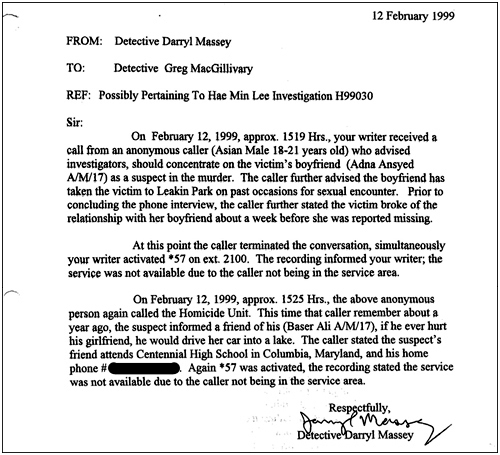
The tip was essentially a nod in Adnan’s direction, with no actual information about the crime or his involvement. Beyond that, it also contained inaccurate information—Adnan and Hae never hooked up in Leakin Park, and they certainly did not break up a week prior to her disappearance; they had broken up at least a month before. Hae’s car, as it turned out, was nowhere near a lake.
Still, the fact that an “anonymous Asian” male thought Adnan deserved their undivided attention supported their existing theory that he was the perp. Did “Asian” mean South Asian, and suggest that someone from Adnan’s community knew something they weren’t divulging? Or did it mean East Asian, and suggest someone from Hae’s community or family with a hunch?
In order to find out, the police set out in search of one “Baser Ali” who turned out to be Yaser Ali, a friend of Adnan’s who was also in his senior year of high school.
Detectives MacGillivary and Carew tracked down and visited Yaser a few days later, on February 15th, meeting him at Pizza Hut in Ellicott City.
Master Ali has known the victim’s prior boyfriend one Adnon [sic] Syed 7034 Johnnycake Road Baltimore, Maryland M/P/17 05/21/81 for numerous years. In fact both boys attend the same Mosque “Islamic Society of Baltimore”. Ali indicated that in the spring of 1998, Adnon became involved with the victim socially and apparently attended the Junior Prom together. As a result of the relationship between Adnon and Hae, Master Ali found that his friendship with Adnon began to dissolve.
Ali also indicated that during the holy month described as “Ramadan” which occurred this year from 23 December 1998 to 16 January 1999. At the conclusion of the month, a festival named “Eid” occurs on 17 January 1999, and was held at the mosque. Ali also indicated that on 17 January 1999, he arrived at the mosque at approximately 5 a.m. He eventually saw Adnon at or about 0730 hours, however, both indicated that they would meet later in the day at one of the parties scheduled. Ali stated that they actually never met up that day, as a result of missing each other between events.
Ali further indicates that Adnon eventually comes over to his house, exact date unknown, however is after the victim is found by the Police. A discussion takes place as to Adnon’s knowledge of how the victim was killed and whether Adnon knew who had killed Hae Min Lee.
Master Ali was asked whether he had heard from other friends about Hae Lee’s disappearance and Ali indicated that [there] were discussions about her, however, nothing pertinent to this investigation.
Master Ali was also asked that if Adnon had killed Hae Min Lee, would Adnon tell anyone? Ali indicated that he didn’t think he would.
Master Ali was asked if he had called Homicide with any information concerning this event, and Ali indicated no.
Ali was then asked if Adnon had been involved, and he wanted to get rid of the car, where would he do so? Ali indicated somewhere in the woods, possibly in Centennial Lake or the Inner Harbor.
Investigation to continue.
Nothing that Yaser said connected Adnan to the crime. Whoever pointed the police in his direction did so futilely. But the police questions show their line of thinking: first, that Adnan may have told someone if he had committed the crime, and second, they still needed to find Hae’s car. The anonymous tip of the 12th didn’t accomplish much in the way of actual evidence, but it paved the way for investigators to narrow their suspect list down to one, Adnan, and was also a convenient excuse to not investigate anyone else.
On the same day that police visited Yaser, Adnan was pulled over for a seatbelt violation—not in itself unusual—but the real reason he was pulled over isn’t known until many years later.
The police investigation continued as Hae’s family and community rallied for her murder to be solved. On the 16th, Detective MacGillivary was informed by the medical examiner that none of the swabs taken from Hae’s body returned any trace of spermatozoa, evidence that she had not been sexually assaulted.
The next day, February 17th, Hae’s church arranged a public vigil, seen in media footage from that evening. Holding lit candles as dusk fell, local Korean Americans walked soberly, singing church songs. They would not let this young girl be forgotten. The police understood, and took the pressure seriously. So much so, they made a special request to the Maryland State Aviation Unit that day to fly over Leakin Park and Woodlawn to help locate Hae’s car. The request was denied.
Another agency was willing to help with the investigation, though: the federal Drug Enforcement Administration.
* * *
The official version of events, the one presented at trial, is this: that on February 18, 1999, detectives sent a subpoena to AT&T Wireless for the cell phone records of one Adnan Syed. There was some major fact-fudging going on here, though.
Later discovered police files show that an earlier subpoena had already been sent to AT&T on February 16th, one that with odd specificity asked for the addresses of thirteen cell site locations. This will be the first time in any of the documents that cell-tower site locations come up. The next time is a February 20th subpoena that requests “a cell site directory that corresponds with the sites listed.” Which means this: while the police were creating a paper trail to make it seem as if they were just beginning their investigation into Adnan in earnest, they already knew that thirteen cell towers were of interest to their case, and they even knew the exact tower sites.
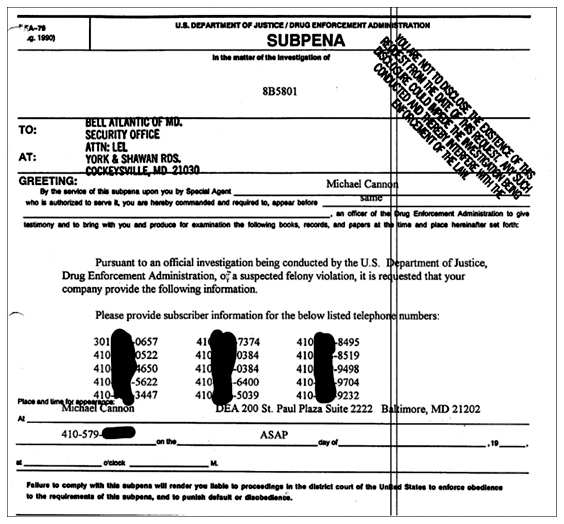
How did the police get this information? There is one strong possibility. The February 18th subpoena was actually not issued by Baltimore City Police, it was issued by the DEA. Asking the DEA for assistance would not heve been all that unusual since the process of getting information took many more hoops for local law enforcement agencies to jump through than it did for federal agencies, and the DEA also had much more experience with gathering cell phone evidence. It could be that the DEA unofficially obtained the records for the police days before the subpoena was issued and never documented that fact.
The DEA subpoena wasn’t even for Adnan’s cell records. It was for the records of all the people called from his phone that day, with one notable exception—the person who was called more times than anyone else on the 13th: Jennifer Pusateri, who would go on to become a key witness in the case.
The police were also working on another investigative lead, trying to identify a tire tread from the crime scene. On the 16th, MacGillivary contacted the local Nissan dealership to ascertain the color of Hae’s car and what kind of tires it used. The tires were Dunlop Brand, model SP 2000, and size P17565R14.
A couple of days later, February 18th, a fax was sent by an employee of Mr. Tire to Detective Ritz with a page full of tire styles.
We don’t know whether or not the police ever matched the tread mark to the tires on Hae’s car, or another car, because there is no further documentation for this issue.
Investigators were also, rather late in the game, trying to assess Hae’s movements on the day she disappeared. They visited her school on the 18th to find out if she owned a locker (she didn’t), contacted her uncle Tae Sue Kim to find out if she had a cell phone (she didn’t), and on the 22nd checked in with the school’s athletic director, Ralph Graham, who told them Hae was with a group of students waiting to be interviewed by a local cable news show the entire morning of January 13th—from 9:00 a.m. to 1:00 p.m. Later it becomes clear that his recollection is wrong; Hae was in class that morning as attendance records note, but his statements end up becoming intertwined with the official narrative.
The investigation was now moving at a rapid pace as police closed out leads, including picking up Sellers from work to administer the second polygraph on February 24th. Having crossed him off the list, they moved on.
On the same day, Metro Crime Stoppers of Maryland, an agency that works with law enforcement to collect crime tips and give rewards, notified the police that, as per their request, flyers had been prepared for release with a press statement notifying the public of a reward in exchange for information about the crime. This seems to indicate that the police never received any actionable leads from the anonymous February 12th tips.
Two days later, on February 26th, Ritz and MacGillivary visited Adnan at home at approximately 7:00 p.m. Adnan and his father greeted them together and offered them drinks. The mood was cordial, though serious. Adnan, along with all of Hae’s friends, was now extremely worried about her and wanted to help in the investigation as much as possible. He assumed the questioning was about when he last saw Hae, or what he knew about her that might help track her down. Instead the questions were focused on their former relationship.
Adnan’s father’s presence made Adnan uncomfortable as he was questioned about his relationship with Hae, answering with a soft “yes” when asked if he was involved romantically with her. He told Ritz that he last saw Hae on the 13th; however, Ritz noted he “doesn’t remember the events that occurred in school that day,” a vague statement that could mean different things, but will eventually be held against him.
When asked if he had ever been in Hae’s car, Adnan responded yes, but not on the 13th. The only thing he cared about was not upsetting his father in that moment. When questioned, he had no idea who would want to hurt Hae and had no information on possible suspects, not guessing for a second that he was their prime suspect. He should have, though. When Hae disappeared my brother Saad told him, “Hey, hopefully she’s ok and turns up soon. Otherwise you know they come after the boyfriends, right?” Saad had even advised him to get a lawyer. Adnan thought he was crazy—why on earth would they consider him a suspect, and a suspect for what? He didn’t give it another thought, just hoped the police would find her soon. In his naiveté Adnan wouldn’t realize what was happening until the next time he was questioned by police, after they arrested him in the early hours of February 28, 1999.
* * *
After leaving Adnan’s home, detectives went in search of Jennifer Pusateri, a friend of Jay Wilds and the person most called and paged from Adnan’s phone on January 13th. They find her in a car, ready to drive off, and she can’t (or won’t) talk, saying she has to drop off dinner for her boyfriend at his workplace. Jenn will later testify that she had gone to see Jay Wilds after this encounter.
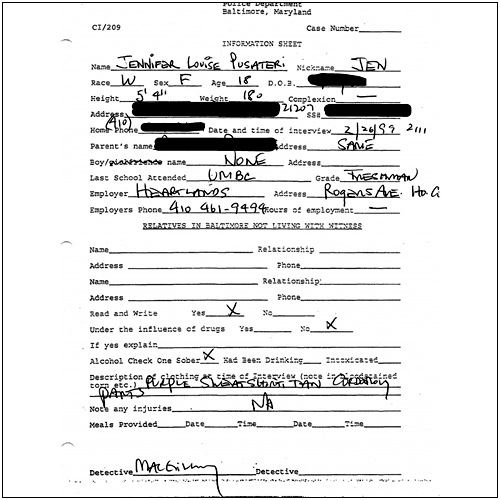
She shows up at the police station about an hour later to answer some questions. The police notes from that meeting are cryptic and make no mention of Adnan whatsoever.
The next morning, on February 27th, the police do a search of the BWI airport parking lot for Hae’s car. Sergeant Lehman contacts Transit Authority at the airport and requests that “all park and ride lots be checked for the victim’s auto, along with satellite parking areas.”
While there is no timestamp on this search report, it appears before (and probably happened sooner than) the events described in the next document, which notes that on the same day around 1:00 p.m. Ritz and MacGillivary visit the home of Jenn’s attorney, who specializes in real estate and coincidentally lived in Ritz’s neighborhood. No notes exist for this interview.
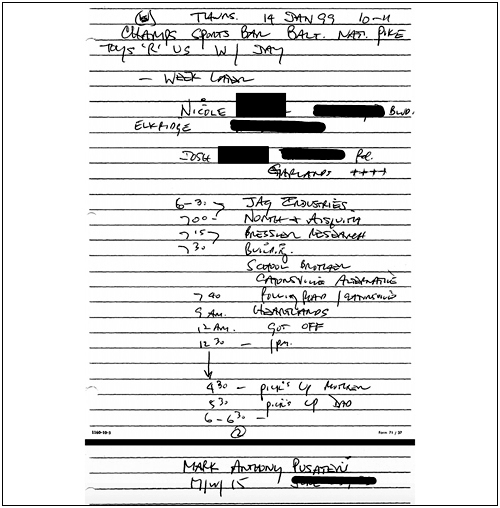
Police notes from initial Pusateri interview, February 26, 1999.
Jennifer Pusateri returns to the police station, this time with her mother and her attorney, and gives a full-length, detailed statement about how Adnan Syed killed Hae Min Lee.
Pusateri is in the station for two hours, during which she gives a confused, nonlinear account of January 13th.
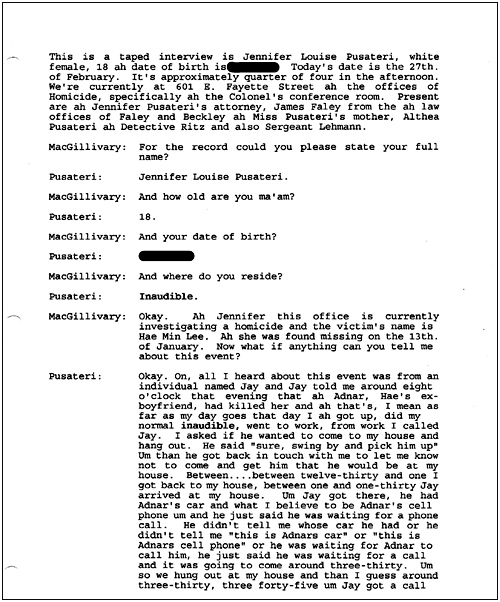
Police notes of second Pusateri interview, February 27, 1999
While she hadn’t previously mentioned Adnan, this time, after having met with Jay the night before, Adnan is now at the center of her story. Jenn says the following:
• On the evening of January 13th, around eight o’clock, Jay told her Adnan strangled Hae
• Jay had come by her house during the day, between 1:00 and 1:30; he had borrowed Adnan’s car (to get his girlfriend Stephanie a birthday gift) and phone, and was “waiting for a phone call.”
• Jay got a call around 3:30 or 3:45 p.m. and then left her house between 3:45 and 4:15 p.m.
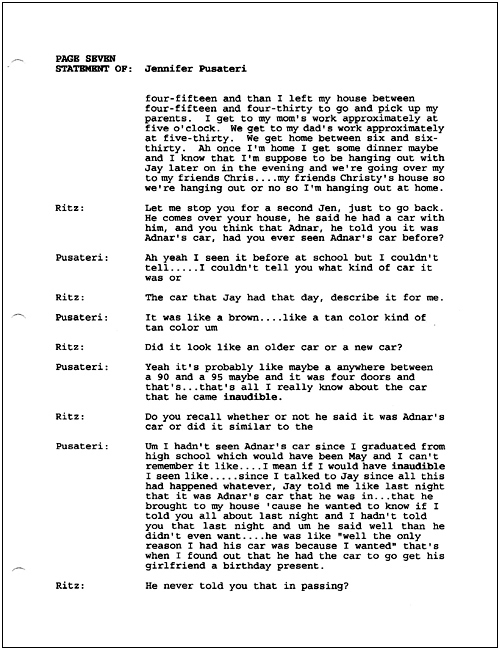
• She received a pager message from Jay to pick him up but the message was confusing, so she called Adnan’s phone between 7:00 and 8:00 p.m. Adnan answered and told her Jay would call her when he needed to be picked up.
• Between 8:00 and 8:30 she got a call or page saying she was to pick up Jay from the Westview Mall parking lot. Jay and Adnan were waiting in a car together when she got there.
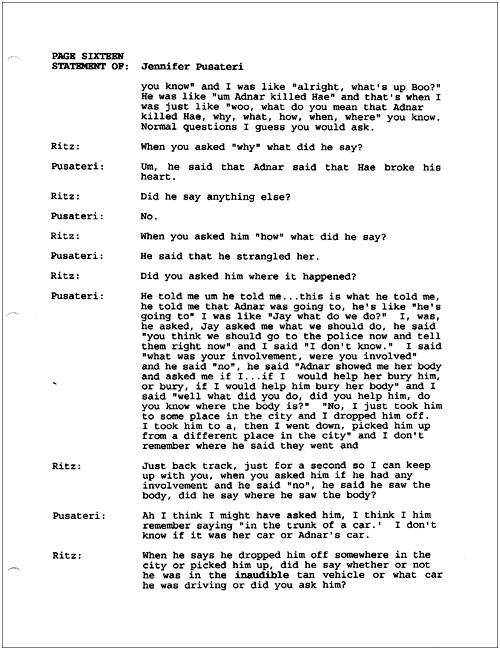
• As soon as Jay got in her car, he told her that Adnan killed Hae, and he saw Hae’s body in the trunk of a car, but that he had no involvement.
• Jay told her Adnan killed Hae in the parking lot of Best Buy and they had gotten rid of the “shovel or shovels” in a dumpster.
• She took Jay to the dumpsters in Westview Mall and he told her to keep an eye out while he retrieved and wiped down the shovel or shovels.
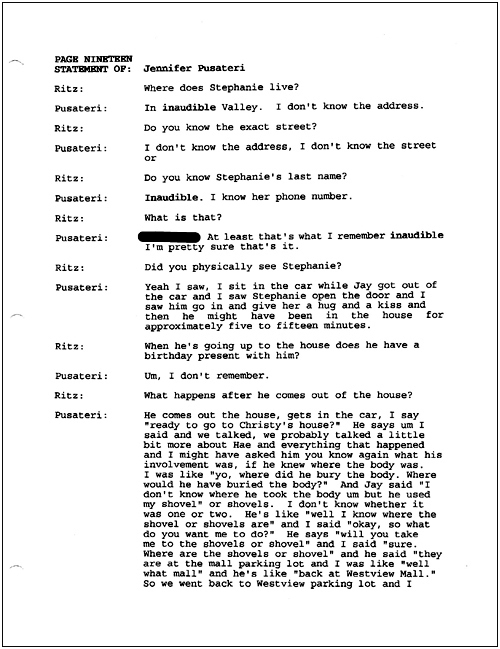
• Jay then told her to take him to see Stephanie and the rest of the night they visited various locations.
• She did not observe Jay’s clothing to be dirty, or his hands to be dirty, and did not notice any unusual behavior with Adnan.
• Jay told her that after seeing the body, he dropped Adnan off in some part of the city and picked him up later in another part of the city; there is no mention of Leakin Park.
• The following day, the 14th, it was raining, and she took Jay to the F&M dumpster so he could get rid of his clothing (though weather reports show it was not raining and emergency ice and snow conditions made most roads impossible to navigate).
And then there is this incredibly odd exchange in which Jenn responds to Detective Lehman’s question of how she knows all this happened on January 13th: “Well the only reason I know that is because last night um when I was being questioned or whatever you want to call it, um ah the question asked was why Adnar [sic] called my house on the 13th, um I remember the incident that Adnar had killed Hae and I remember I had talked to Jay that day and Jay had been at my house.”
Lehman then asked, “So you’re saying that you’re sure it’s the 13th because we told you you had these telephone calls on the 13th?”
“Right,” Jenn responded.
* * *
The interview wraps up a bit after 5:00 p.m. and Jenn walks out, having just essentially confessed to being an accessory after the fact.
Late that night, on February 27th, for the first time, according to official documentation, the police pick up Jay Wilds.
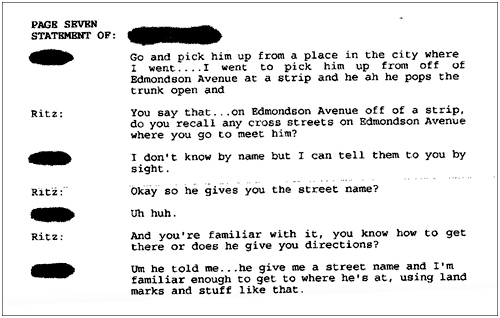
According to police notes, there is an unrecorded two-hour “pre-interview” with Jay before the tape recorder is turned on. The taped interview lasts for hours and is filled with contradictions and internal inconsistencies. He gives this basic narrative:
• On the evening of January 12th Adnan calls and they briefly chat, making plans for the next day.
• On the 13th Adnan arrives at his home around 10:30 a.m. and they go to Westview Mall and do a little shopping together.
• He drops Adnan off at school around 12:30 p.m. and keeps his car; Adnan leaves his cell phone in the car.
• Before Jay drops him off, Adnan mentions that he is going to kill Hae that day because she broke his heart.
• Jay, unperturbed, agrees to pick Adnan up later that day from wherever he needs to be picked up from; he then goes to Jennifer Pusateri’s home where he plays video games with her brother, Mark. Jenn is not home.

• He gets a call from Adnan around 3:45 p.m. to meet him somewhere in the city.
• In his first mention of Hae’s car, they leave the body and the car in the Interstate 70 Park-n-Ride close to Leakin Park and then go smoke weed together.
• He drops Adnan back off at school “when the sun was going down,” around 4:30 p.m. (the sun set at 5:06 p.m. that day), for track practice.
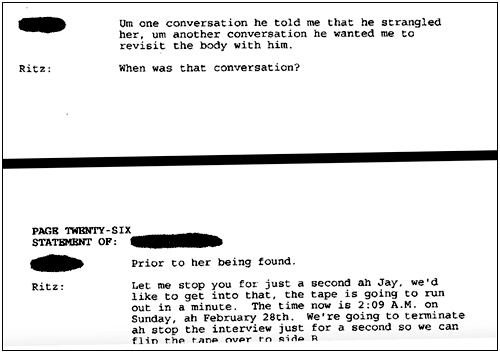
• He picks him back up at 6:45 p.m. and they go for a bite to eat, when a police officer calls to ask Adnan if he’s seen Hae.
• Adnan panics and asks Jay for shovels. They go to Jay’s house and he gets a pick and a shovel.
• They return to get Hae’s car and Jay follows Adnan to Leakin Park, where he watches Adnan dig a hole as Hae’s body lies on the ground.
• He notes Hae’s jacket is on the ground and that Adnan throws it somewhere.
• Adnan tells him to follow him as he finds a place to park Hae’s car; they end up in a lot by some row homes, where Jay says Adnan takes Hae’s wallet and book bag and gets in his car with Jay.
• As Jay is driving himself home, Adnan asks him to stop at a dumpster to get rid of things—Hae’s purse, wallet, book bag, and the shovel/pick.
• Jay discards his clothing in his own trash can.
• Once the tape is flipped, Jay begins describing the windshield wiper in the car being kicked and broken by Hae as she was being strangled, a detail Adnan had apparently given him.
• Adnan never told him how he got in Hae’s car.
Jay goes on to mention that Adnan told “Tyad” (likely Tayyab), a Pakistani Muslim, that he had murdered someone, but did not actually specify who he murdered. Casually telling a friend about an unspecified murder you committed, it seems to Jay, is a routine thing in Pakistan. It may be that Jay got that idea from somewhere.


The detectives wrap up the interview by asking Jay nicely to take them to Hae’s car and he complies. The car is officially located at 2:45 a.m. on a grassy parking lot lined on all four sides by row homes on the 300 block of Edgewood Drive, less than three miles from where Hae’s body was found.
The car is towed to police headquarters and at approximately 5:20 a.m. the police arrive at Adnan’s home with an arrest warrant.
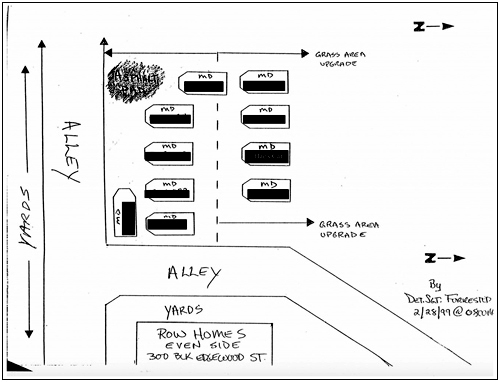
Officer sketch indicating location of Hae’s car